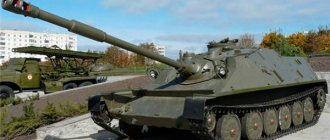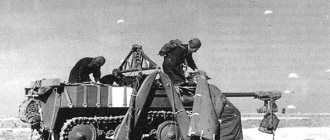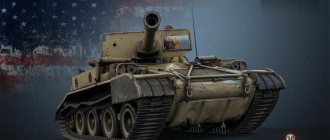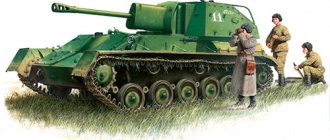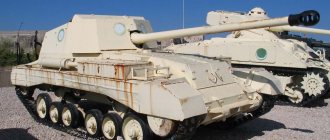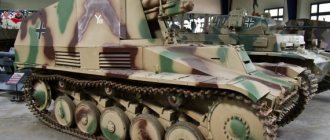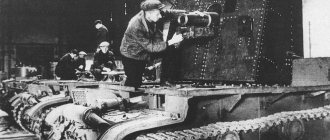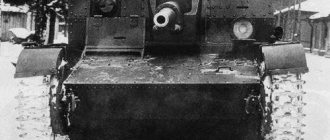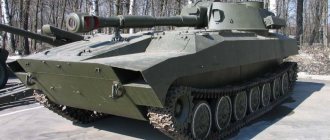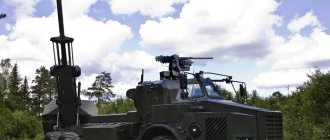| This article requires additional links for verification . |
Type of tank destroyer
| Rifle, salvo 106 mm, self-propelled, M50 "Ontos" | |
| Ontos M50A1, 50 caliber anti-aircraft rifles can be seen on the upper guns. | |
| Type | Tank Destroyer |
| Place of origin | United States |
| Service history | |
| In service | 1956–69 |
| Used | United States |
| Wars | Vietnam War Dominican Civil War |
| Production history | |
| Designer | Allis-Chalmers |
| Designed by | 1952 |
| Manufacturer | Allis-Chalmers |
| Produced | 1955–57 |
| No. built | 297 |
| Options | M50A1 |
| Characteristics | |
| Weight | 8,600 kg (19,000 lb) |
| Length | 3.83 m (12 ft 7 in) |
| Width | 2.59 m (8 ft 6 in) |
| Height | 2.13 m (7 ft 0 in) |
| Crew | 3 (driver, gunner and loader) |
| Main weapons | 6 × M40A1C recoilless rifles |
| Secondary weapons | 1 × 0.30 (7.62 mm) M1919 Browning machine gun |
| Engine | 6-cylinder in-line gasoline engine GM 302 cc. In (4.95 l), 145 hp (108 kW) |
| Operating range | 185 km (115 mi) |
| Maximum speed | 48 km/h (30 mph) |
Ontos
, officially
called
Repeating
106mm Self-Propelled
Vehicle
, the M50
, was an American light armored tracked anti-tank vehicle developed in the 1950s.
For its main armament, it mounted six hand-loaded 106 mm M40 recoilless rifles, which could be fired in rapid succession at single targets to ensure kills. Although the actual caliber of the main gun was 105 mm, it was designated 106 mm to avoid confusion with the ammunition for the M27 105 mm recoilless rifle, which the M40 replaced.
It was produced in limited quantities for the US Marine Corps after the US Army abandoned the project. Marines consistently reported excellent results when they used Ontos for direct infantry fire support in numerous battles and operations during the Vietnam War. The American stockpile of Ontos was largely depleted by the end of the conflict, and Ontos was withdrawn from service in 1969.
Development[edit]
Project Ontos
(Greek: "Thing"[1]) was designed as a carrier-based tank destroyer capable of being carried aboard a 1950s cargo plane. This limited the vehicle's weight to 10 to 20 tons. The Ontos would also use the six-cylinder engine then commonly used in GMC military trucks. On August 12, 1955, Allis-Chalmers entered into a contract for the supply of 297 vehicles.
The first Allis-Chalmers vehicle, built in 1952, was based on the undercarriage of the M56 Scorpion light anti-tank vehicle. The vehicle has a cast steel turret with two weapons, each with three rifles. This early model could only rotate the turret about 15 degrees. The second prototype used a new suspension system, new tracks and a new turret with a traverse angle of about 40 degrees. Due to limited space, the vehicle could only carry eighteen rounds for the main gun inside the vehicle. Also attached to the four recoilless rifles were M8C .50 BAT (12.7x77mm) anti-aircraft rifles, each of which fired tracer rounds with the same trajectory as a 106mm round and emitted a flash and a cloud of white smoke upon impact . Sighting rifles were used to guide the 106 mm recoilless rifles to the target. The Ontos also carried a single M1919A4 .30 caliber (7.62 mm) machine gun for anti-personnel purposes.
The vehicle was delivered to the Aberdeen Proving Ground, where single rifles had previously been tested. When all six guns were fired simultaneously, the shot in the back knocked out bricks in a nearby building and shattered the rear windows of several cars. The prototype and testing phase was completed by 1955, after which the Army canceled its order.
As an anti-tank vehicle, the Ontos had several problems, including its small ammunition load, a very high profile for such a small vehicle, and the need for the crew to exit the vehicle to reload the guns, exposing them to enemy fire. . Although the Army canceled its order, the Marine Corps was desperate for any anti-tank vehicles they could get and ordered 297. Production ran from 1955 to 1957. On October 31, 1956, the Marine Corps received its first vehicle.
Options and improvements[edit]
Several options were also explored. Utility Vehicle, tracked, infantry, T55
There was a light Armored Personnel Carrier (APC), but only two versions of the prototype were built.
This proved impractical due to the limited space inside, which only carried five infantrymen and required the driver to lie prone. A "stretched" version was also built, known as the Utility Vehicle, Tracked, Infantry, T56
, and although it carried a full crew of eight, their equipment had to be carried outside. Neither was considered very useful.
In 1960, little research was done into replacing the 106 mm Ontos rifles with a new 105 mm rifle that included a revolver-style autoloader. This project was not accepted.
Another proposed upgrade was to replace the GMC engine with a newer Chrysler 361 cu.in. Inch (5.92 L) V8. This modernization was carried out, and the variant was named Rifle, Multiple 106 mm, Self-propelled, M50A1
. However, of the 297 vehicles initially accepted by the Marine Corps, only 176 were converted to this standard between 1963 and 1965.
Ontos - 106 mm M50 multi-barrel anti-tank self-propelled artillery mount
Ontos means "thing" in Greek. When applied to a Marine armored vehicle, this could mean "rare." This armored vehicle made a significant contribution to the success of the Marine Corps and US Army operations in Vietnam, but less is known about it than any other armored vehicle produced by the US military. Even among military vehicle collectors, the name Ontos often raises eyebrows. The reason for this may be due to the fact that Ontos were produced in small quantities. Thus, by the beginning of the Vietnam War, the US Marine Corps had only 176 vehicles. Another factor is that the Marines quickly disposed of the remaining armored cars, destroying most of the hulls and gun mounts. Only a few surviving examples of the Ontos have found their way into museums and the hands of collectors, and its story remains untold. Today, more tanks from the First World War survive than Ontos.
General Overview The Ontos was a relatively light tracked fighting vehicle developed in the early 1950s with the purpose of destroying the main battle tanks of the time with six 106mm recoilless rifles. Despite its miniature dimensions: 3.81 meters long, 2.6 meters wide, it accommodated three crew members in a compartment slightly more than 1.2 meters high. She served in the US Marine Corps from 1956 until 1970, when most of them were scrapped. Her service in the Marine Corps coincided with the Corps' use of 106 mm recoilless rifles.
Ontos first gained combat experience 10 years after it was put into service. This happened when it was used against rebels in the Dominican Republic in April 1965. The second combat use was in Vietnam, where it played a role that had nothing to do with what this small, fast tank destroyer was originally intended for.
If it is true that any army in a current war uses tactics and equipment from its last war, then the mark of a successful army is its ability to adapt everything that can help it accomplish a new mission. Ontos and its crews had to convince Marine Corps brass that the combat vehicle had the right mission in Vietnam. Success in convincing his command of Ontos' potential was not so clear-cut. The vehicle was deployed at the company level and convinced the leadership with its enormous firepower needed by the infantrymen; firepower capable of influencing the outcome of the battle.
I am struck by the similarity between the use of the Ontos within an infantry company and the use of the small Stewart tank by the Marines in the Pacific battles of World War II. Both were lightly armored and unable to withstand weapons above 50 caliber. Both of these vehicles were effective due to their small size and ability to provide infantry with relatively high firepower in combat. Their size allowed them to operate in areas where larger tanks could not. Half a meter wide tracks allowed the 9-ton Ontos to operate on the soft soils surrounding the rice fields of Vietnam. Both of them were used to destroy fortified positions (bunker busters). Thanks to their proximity to the front lines, their ability to be quickly deployed and to overcome fortified enemy positions, infantry losses were significantly reduced.
Ontos, like a hive, shoots out hundreds of bees, capable of clearing the jungle of the enemy with their stings. Then there was no other weapon capable of clearing the jungle to a depth of 400 meters, like 106-mm recoilless rifles with cluster shells with ready-made arrow-shaped striking elements. The effectiveness of artillery shells and bombs was limited to the direct impact area. The jungle vegetation absorbed the blast wave and flying debris. Other vehicles with 106 mm recoilless rifles mounted on them were open to enemy small arms fire. The Ontos could expose itself to enemy small arms fire for a short period of time to release its ammunition when needed and retreat to a safer location to reload. It was an armored shotgun, and the North Vietnamese army was afraid of it.
It is no surprise to any military veteran of any country that weapon systems are misused, unsatisfactory and/or forgotten by the generals who demanded their development. Ontos suffered the same fate. The deployment of the Ontos seemed to be very well thought out by many commanders, and the provision of spare parts for the Ontos was a major concern.
Ontos was developed in a different era for different purposes. Designed to destroy tanks, the Ontos proved obsolete even before it was in the hands of its first crew. It went to soldiers who rethought its use and turned it into a weapon for the Marine Corps.
Ontos crews were selected from Marine battalions to train as gunners, radio operators, mechanics, and tactics. Marines assigned to infantry battalions were designated 0300. Ontos crews were made up of former fighters from various military specialties. Some of the crew had experience with vehicles, but most were probably former gunners. After their assignments to anti-tank units, they usually returned to the battalions from which they came to be assigned to other anti-tank units.
The naval high command was unanimous in sending the Marines against the North Vietnamese army and Viet Cong fighters. They were confident that individual Marines, combined with traditional artillery and air cover, could defeat this enemy, which did not possess such weapons.
Everyone believed that Vietnam was not capable of tank operations. If he could, he would have put armored vehicles on the battlefield. Since tanks were not advanced by North Vietnam, there was little use for the small anti-tank armored vehicles known as Ontos or "pig".
The Marines brought M48A2 tanks and 106 mm Ontos multi-barrel anti-tank self-propelled artillery into battle, but they were not the focus of regimental and battalion commanders on a par with traditional weapons such as 81 mm and 107 mm mortars, 105 mm artillery and close air support.
The deployment of Ontos was often driven by the instinctive decisions of battalion commanders. They were used primarily as perimeter defense with some limited duties.
The Vietnam War was controlled by American politicians; with the rules of engagement completely confusing the military command. The American Air Force was prohibited from bombing air defense positions that had exhausted their ammunition. At the beginning of the Vietnam War, the enemy could retreat into areas that American troops were prohibited from entering. These rules, as applied to Ontos crews, meant that the use of their main battery, or even its loading, could only be carried out with the permission of the battalion command. In the beginning, Ontos crews had to go into combat areas with unloaded guns. Later they were allowed to load 106 mm guns, but they did not have the right to open fire at their own discretion. These rules were a nightmare for veterans of World War II or the Korean War.
If the Marine Corps command ignored the advantages of Ontos, then the North Vietnamese army was quite the opposite. One thing comes through in almost all of my interviews with Ontos crew members. The North Vietnamese Army feared Ontos and avoided contact with her whenever possible. Most contacts between the North Vietnamese Army and Ontos were incidental on the part of the Vietnamese.
Development The Ontos project was entrusted in early November 1950 to the agricultural machinery manufacturer Allis-Chalmers, a Wisconsin division. The Allis-Chalmers design department consisted of approximately 50 to 60 engineers, 90% of whom were involved in the development of the first prototypes. All prototypes were built at the Agricultural Assembly Plant in LaPorte, Indiana.
The project was first conceived by the government as a tank destroyer capable of being transported on 1950s-era cargo planes. The contract provided for the supply of 1000 vehicles to the army. In 1953, the army refused to accept Ontos for service, in turn, the Marine Corps accepted about 300 vehicles.
The government customer, represented by chief engineer Carl Holmyard, compiled a technical specification of just one sheet. According to him, the vehicle was to be equipped with the same six-cylinder GMC gasoline engine as the standard 2 ½-ton military trucks of the day and a front-mounted Allison transmission transmitting torque to the tracks. The rest of the technical specifications limited the external dimensions and weight of the vehicle in order to ensure air transportability.
The project was classified as "Confidential". This is the lowest level of secrecy for government work, but it still required that the prototypes be built in a fenced-off section of the farm machinery plant. The government was ready to accept prototypes for testing only after the machines had worked for 50 hours. This required engineers to come into the plant on weekends and run prototypes around the Ellis-Chalmers plant.
Ontos had two large booms on which six recoilless rifles were mounted. These rods were connected to a sunken tower. This entire structure was made of armor steel. Early prototypes could turn the guns less than 15 degrees left and right. Production Ontos were already capable of turning their guns 40 degrees left and right.
Welding the armored hull proved problematic for Ellis-Chalmers. Several prototypes were ruined while practicing proper welding techniques.
The first Ontos prototype had tracks similar to those used on the Scorpion self-propelled artillery mounts. They were subsequently changed. This first Ontos prototype still exists and is in the hands of collector Fred Ropkey.
The subsequent and final tracks and suspension were of a new design. Each track consisted of two rubber sections 1.2 meters long with steel teeth in the center. Steel lugs half a meter wide connected the rubber and the ridge. To compose one caterpillar, 5 sections were used. A motivated crew could complete the track section replacement in about an hour and a half. One sailor told me in a conversation that they were able to repair the track in 42 minutes.
The suspension system was designed in such a way that none of its mechanisms encroached on the already small fighting compartment. The track rollers were connected through balancers to torsion shafts attached to the sides of the hull. Much attention was paid to the special rubber compounds of the bushings.
A rubber soft fuel tank was installed in the front of the vehicle directly behind the front plate. It was molded from rubber and contained tubular passages through its center to allow the left drive shaft to transmit torque through the fuel tank to the left drive sprocket.
Allis-Chalmers developed a deep wading kit for the Ontos, but it was not adopted by the Marine Corps. It consisted of a waterproof cover for the engine, thus keeping the engine dry while wading. The fording devices were carried on the Ontos and had to be installed immediately before crossing the water obstacle.
One of the problems that Ellis-Chalmers had to solve was related to the location of the track. The lower part of the chassis was made by welding. Welding distortions affected the suspension location, resulting in the loss of the track. Replacing welding with machining the lower hull where the suspension bolts to the hull finally solved this problem.
Allis-Chalmers also developed an armored personnel carrier based on the Ontos tracked design. The armored personnel carrier was equipped with one additional 1.2 meter tracked section. There are no known photographs confirming the existence of a prototype armored personnel carrier.
Most of the design work was completed in 1950 during a two-week design marathon. The Marine Corps tested the vehicle over the next six years and eventually accepted it into service at the end of 1956. In his report, the chief engineer notes that between 1957 and 1959 a number of changes were made to the design. This report by Chief Engineer Craig Cannon relates to a major revision of Ontos called "Project 1960". Some of the proposed changes called for the use of an aluminum amphibious hull and two 105 mm recoilless rifles (designated T237 guns) equipped with a cylindrical revolver-type charger. This change would allow the two guns to be fired multiple times without one of the crew having to leave the vehicle to reload the guns from outside. Another important change involved replacing the engine with a turbine engine. The 1960 Project was not accepted.
One of the first tests was the sighting system for a six-gun turret. Part of the testing involved firing all six guns simultaneously. The armored car being tested was delivered to a training ground in Aberdeen, specially built for testing 106 mm recoilless rifles. No one imagined the effect of firing six guns at once, at least none of those who planned the test complex. Backfire from the shooting tore several bricks from a nearby building and blew out the rear windows of several cars.
Allis-Chalmers later modernized the Ontos, replacing the 6-cylinder engines with Chrysler 6-liter V8s. The upgrade also included replacing the armored engine cover with additional ventilation. It is believed that out of 300 vehicles manufactured, only 176 Ontos were modernized.
Ontos armored hull
The Ontos frontal armored plate, 129 cm wide, had a thickness of 25 mm. The front plate formed the front part of the vehicle body and protected the driver and transmission from ground level to a height of 70 cm. The side sheets to which the suspension elements are attached form the side walls of the fighting compartment, slightly thicker than 12.7 mm. The bottom of the fighting compartment is made of 6.5 mm thick armor steel. Most of the rest of the hull is made of 12.7mm thick armor. The front engine covers are cast from armored steel and their louvres have 10mm stripes on the inside of each louvers to prevent small arms fire from entering the engine compartment.
It was rumored that Ontos had a high center of gravity and had a tendency to tip over. I discovered that the vehicle with the guns removed still weighed more than 5 tons. The center of gravity of these five tons was located within the height of the tracks (86 cm). Therefore, I doubt that Ontos had a high center of gravity. The crew members told me that the car seemed to skid when going up a steep hill before flipping over.
106 mm recoilless rifles
Ontos had the ability to fire its 106 mm recoilless rifles one at a time, several at a time, or even all at once. Four of the six guns had coaxial 12.7 mm machine guns. The firing range of the machine guns approximately corresponded to the firing range of a 106 mm projectile. These machine guns were used as an indicator (tracer), since when they hit, a cloud of smoke was formed. Firing of the weapon was controlled by a gunner located behind the driver and engine. The gunner often fired the tracer at the target first and followed its flight. Often, without waiting for the tracer to hit the target, he fired 106-mm shells. The maximum firing range of the 106-mm projectile was about 2700 meters. The 106mm gun is generally considered a direct fire weapon, but crews were trained to use it from indirect firing positions against targets not within the gunner's line of sight.
The 106 mm recoilless rifle is more than 3.4 meters long and weighs about 130 kg each. The Ontos tower had to carry more than 770 kg on uneven ground. The load on the artillery mountings forced the crews to periodically level the guns.
Two of the six guns could be easily removed from a self-propelled artillery mount and, if necessary, used from a ground installation.
Combat organization Ontos
The Ontos crew consisted of three people: driver, commander/gunner and loader. In cases where the Ontos was carrying a lot of ammunition and/or other cargo, or in very hot weather, the loader could be seen sitting on the driver's hatch, on the machine gun crossbar, or in the platoon's ¾-ton Dodge truck, often following the platoon on the march. Ontos could, and in practice did, travel with their rear doors open wherever possible. This method of movement, to put it mildly, did not prevent road dust from getting into the fighting compartment, which made the crew look like pigs. For this reason, crews usually call Ontos "pig".
Crew training was varied and kept up with the changing demands of the war. Until March 1965, crews trained at Camp Horno, home to the 1st Marine Division, and Camp Pendelton on the California coast near Los Angeles. Later, crew training took place on site in the units to which they were assigned. They had to study: vehicle maintenance, small arms, tactics of use, as well as direct and indirect fire. All Marines were trained in the use of small arms, but Ontos crews also used machine guns not used by most Marine units. They also had to know how to use the three main radios and the intercom. Some aircrews deployed to Vietnam initially went to training ranges on Okinawa for extended day and night firing with 106 mm guns.
Ontos crews had to be able to replace 1.2 meter sections of tracks. They also had to be able to pull up a track that had been repaired or had gone through a series of sharp turns. An Ontos mechanic was assigned to each platoon, but crew members were also assigned to help keep the vehicles in working order. Platoons were often dispersed when assigned to infantry units. The platoon mechanic was often unavailable to carry out necessary repairs. Spare parts were often difficult or even impossible to obtain. Due to this, many Ontos were dismantled for spare parts.
Ontos platoons were organized into heavy and light squads. There were three Ontos in the heavy section and two Ontos in the light section. There were three platoons per company and three companies in the Ontos battalion. The 1st and 3rd Ontos battalions saw action in Vietnam. The cars were in Vietnam from early 1965 to mid-1969. There is some evidence that at the end of 1965 there were 65 Ontos in Vietnam. If this figure is correct, it is likely that 45 Ontos were part of the 3rd Naval Anti-Tank Battalion and a smaller number in the 1st Naval Anti-Tank Battalion, and some vehicles were on board ships in anticipation of their deployment to any of the hot spots, in if necessary.
The Ontos crew had 6 106 mm shells in their guns. Another 8 shells were placed in the rear of the installation under the rear hatches and 4 shells in a rack located in the right rear of the vehicle. The loader had to dismount and reload the guns from this ammunition rack. Depending on the situation, the fighting compartment of the vehicle could accommodate additional ammunition. I interviewed an Ontos platoon sergeant who had removed the driver's and commander's seats and placed 30 extra rounds in the cramped space. He sat on ammunition while driving or firing a gun.
The crew also carried an M-3A1 machine gun (also known as a "grease gun" or SMG) and a Colt 45 light machine gun and 250 rounds of ammunition each, 1,000 with tracer bullets for the coaxial 12.7mm M8 machine guns, and 1,000 or more rounds of ammunition for the Browning 1919A4 machine gun. Many of the crew members also had personal small arms. Some of the personal weapons included shotguns and captured weapons such as the Thompson submachine gun, AK-47, Simonov automatic rifle, and French machine guns. One crew I know also mounted a 60mm mortar on the front of the Ontos.
Marine infantry battalions at that time were armed with M60 machine guns. For some unknown reason, the Ontos were armed with old Browning light machine guns. Some crews had the option of switching to more modern, fully automatic weapons, but they chose the Browning. It was believed that the old Browning required less frequent barrel replacements under heavy use. The Browning machine gun was mounted on the gun mount/turret mounts. It could be controlled manually or remotely from inside the Ontos via a foot pedal.
What happened to Ontos?
The Marines stopped using Ontos in Vietnam in May 1969. Some Ontos remained in Vietnam and were assigned to the Army Light Infantry Brigade near Tam KY. The army used them until it became impossible due to a lack of spare parts. They were then converted into fixed firing points. In May 1969, the remaining vehicles in Vietnam were loaded onto ships and returned to the United States. The crews were transferred to various Marine battalions.
Upon the vehicles' return to the United States, the top portion of the hull was cut off and many of the chassis were sold as construction equipment or donated by local government agencies for salvage work.
Ontos that exist today are known to the author (In this section, the author lists museums in the USA where you can see and touch real Ontos. Those interested can follow the link and ask for the addresses of the museums.)
Memories of crew members about their Ontos (In this section, the author provides the memories of 6 Vietnam War veterans about their experience using Ontos. Those who wish to familiarize themselves with these memories can use the link to the original article.)
Conclusions My conclusions about Ontos are based on my conversations/correspondence with two Ontos developers who previously worked for Ellis-Chalmers, sixteen former Ontos crew members and personal experience restoring four cars that I own to date. I can also rely on my poor memory of cars when I was in the Marines.
My memories of the Ontos include the smooth, quiet sound emanating from the engine and exhaust when accelerating on the road. The gears shifted accurately. As an avid racer before serving in the Marine Corps, the engine/transmission combination reminded me of the heavily modified hydrodynamic transmission used on the auto racing circuit in the early 1960s.
I also remember the slightly suspended suspension. The suspension had more travel than the M48 main battle tank. She looked more springy.
I'm surprised by one of the main criticisms of Ontos that goes something like this: 106mm recoilless rifles give away their positions due to excessive smoke, noise and dust raised by backfire when firing. The crews were trained, and common sense dictates that after the guns fire, the vehicle should leave its position. This is called "roaming gun tactics." I can’t think of a primary weapon that wouldn’t be fired to reveal its position. I don't recall silencers on artillery or tanks.
Many crews agreed that the tracks were weak. The steel lugs were breaking. The tracks were assembled with small bolts, whose heads tended to become rounded as they moved on the sand.
The turret/gun mounting could have been made more massive as it was bending from the weight of the six guns bouncing on uneven ground.
Another valid criticism was the need for the loader to leave the relative safety of the vehicle to reload recoilless rifles from the outside. When Ontos operated in groups in a confined space, crews had to ensure that the Ontos' backfire did not kill the loader of another Ontos while his vehicle was reloading.
The Ontos were in the middle of their life cycle when they arrived in Vietnam. They proved their usefulness even at the end of their life cycle and even when the 106 mm recoilless rifles needed replacement.
It proved its effectiveness in indirect fire when it operated with M48 main battle tanks in repelling the only major attack at the Siege of Khe Sanh. Ontos were buried in trenches and fired at the enemy, invisible to the crews.
She turned out to be the main street fighter in the narrow alleys of Hue. Its guns knocked out the hidden enemy from buildings from a distance of up to 3,000 meters, as well as at point-blank range.
By the time this machine gained recognition, its weapons were outdated and there were no spare parts for it. The mechanics made incredible efforts to keep the machines running, sacrificing one machine for the sake of two others. The vehicles of the Third Anti-Tank Battalion were in terrible condition and the vehicles of the First Battalion were not in much better condition when they took part in the largest Marine battle in Vietnam at Hue. After the loss of vehicles and people in Hue, Ontos had reached its limit. Their crews were returned to their battalions and a small portion of the vehicles were returned to California for disposal.
Service [edit]
Although the M50 was designed as a tank destroyer, during the Vietnam War most M50s failed to engage enemy armor as the North Vietnamese Army deployed few tanks. Therefore, the Ontos was used more widely by the USMC for direct fire support for infantry in combat, a role that was never emphasized in training or exercises. Its light armor was effective against small arms fire, but vulnerable to mines and rocket-propelled grenades. Consequently, many Ontos were deployed in static defensive positions.
The M50's relatively light weight made it exceptionally mobile for such firepower. During one operation, Ontos was the only tracked vehicle light enough to cross a pontoon bridge. At the Battle of Hue, Colonel Stanley S. Hughes felt that the Ontos was the most effective of all Marine auxiliary weapons. At ranges of 300 to 500 yards (270 to 460 m), its recoilless rifles could punch holes in walls or destroy them completely. The appearance of the Ontos was sometimes enough to cause the enemy to crash and flee, and unofficial reports describe the enemy fleeing occupied buildings when an Ontos shell hit a window. The large naval stallion CH-53 is introduced into Operation Desoto. The helicopter allowed the platoon to be moved 25 miles (40 km) south of the city of Quan Ngai, carrying Ontos on slings below the aircraft. [2]
The Ontos units were deactivated in May 1969, and some of the vehicles were transferred to the Army Light Infantry Brigade. They used them until they ran out of spare parts, and then removed the towers and used them as permanent fortifications. Both these and the remaining vehicles returned from Vietnam in 1970 and were dismantled for scrap, and some chassis were sold to be converted into construction vehicles. Some of the Ontos that were sold to construction companies were later acquired by collectors for restoration.
The Ontos did see use as an anti-tank weapon during US involvement in the Dominican Civil War: on April 29, 1965, M50 Ontos and M48 Patton from the 6th MEU attacked and destroyed two rebel L/60L light tanks, each destroying one. In another incident, Ontos destroyed an AMX-13. [3]
Development
To Ontos
(Greek for "thing"[1]) the project was created as an air transport tank destroyer capable of being lifted by a 1950s cargo plane. This limited the vehicle's weight to 10 to 20 metric tons. The Ontos would also use the six-cylinder engine then commonly used in GMC military trucks. Allis-Chalmers signed a contract on August 12, 1955 for the supply of 297 vehicles.
The first Ellis-Chalmers vehicle, built in 1952, was based on the chassis of the M56 Scorpion light anti-tank vehicle. The car is assembled from cast steel. turret with two arms with three rifles in each. This early model could only rotate the turret about 15 degrees. The second prototype used a new suspension system, new tracks and a new turret with a traverse angle of about 40 degrees. Due to limited space, the vehicle could only carry eighteen rounds for the main gun inside the vehicle. Also attached to the four recoilless rifles were M8C .50 BAT (12.7x77mm) anti-aircraft rifles, each of which fired tracer rounds with the same trajectory as a 106mm round and emitted a flash and a cloud of white smoke upon impact. Sighting rifles were used to guide the 106 mm recoilless rifles to the target. The Ontos also had a single .30 caliber. M1919A4 machine gun for anti-personnel use.
The car was delivered to the Aberdeen Proving Ground where single rifles had previously been tested. When all six guns were fired simultaneously, the shot in the back knocked bricks out of a nearby building and shattered the rear windows of several cars. The prototype and testing phase was completed by 1955, after which the Army canceled its order.
As an anti-tank vehicle, the Ontos had several problems, including its small ammunition load, a very high profile for such a small vehicle, and the need for the crew to exit the vehicle to reload the guns, exposing them to enemy fire. . Although the Army rescinded its order, the Marine Corps was desperate for any anti-tank vehicles it could get and ordered 297. Production ran from 1955 to 1957. On October 31, 1956, the Marine Corps received its first vehicle.
Options and improvements
Several options were also explored. In Utility Vehicle, Crawler, Infantry, T55
There was a light Armored Personnel Carrier (APC), but only two versions of the prototype were built.
This proved impractical due to the limited space inside, which only carried five infantrymen and forced the driver to lie prone. A "stretched" version known as the Utility Vehicle, Tracked, Infantry, T56
was also built, and although it carried a full crew of eight, their equipment had to be carried outside. Neither was considered very useful.
In 1960, a small study was conducted to replace the 106 mm Ontos rifles with a new 105 mm rifle that included a revolver-style autoloader. This project was not accepted.
Another proposed upgrade was to replace the GMC engine with a newer Chrysler 361 cu V8 engine. This update was implemented and the variant was named Rifle, 106 mm salvo, self-propelled, M50A1
. However, of the 297 vehicles initially accepted by the Marine Corps, only 176 were converted to this standard between 1963 and 1965.
Preserved cars on display[edit]
M50 Ontos on display at the National Museum of the Marine Corps.
Ontos are exhibited in the following locations in the US:
- Patton Cavalry and Armor Museum at Fort Knox, Kentucky [4] (no longer on display, may have moved with the armor school to F. T. Benning). [ citation needed
] - Rock Island Arsenal Museum in Rock Island, Illinois. [ citation needed
] - Camp Atterbury, Edinburgh, Indiana. [ citation needed
] - The American War Museum in El Monte, California has an M50 missing six recoilless rifles. [ citation needed
] - The Aberdeen Proving Ground Museum in Aberdeen, Maryland has the 19th T165E2 prototype, which is not currently on display. The car is currently [ when?
] is undergoing cosmetic restoration.
[ citation needed
] - Mr. Fred Ropkey, owner of the Ropkey Armor Museum in Crawfordsville, Indiana, owns an early prototype T165, a later model Ontos, and a parts machine. [ citation needed
] - The National Museum of the Marine Corps in Quantico, Virginia has completed the restoration of the M50A1 Ontos.
- The Museum of the Marine Corps in Jacksonville, North Carolina has an operational M50A1 Ontos that is not on public display. [ citation needed
] - An M50A1 Ontos is on display at the Naval Air Station's exterior display in China Lake, California. [ citation needed
] - Marine Corps Ground Warfare Center Twentynine Palms, California, displays an M50A1 Ontos. [ citation needed
] - The Military Transportation Technology Foundation in Portola Valley, California has a T165E1 prototype with an original GM 302ci engine that is currently undergoing a complete restoration, and a second T165E2 Ontos prototype. [ citation needed
] - US Army Artillery Museum at Ft. Windowsill, Oklahoma. [ citation needed
] - The Marine Corps Mechanized Museum at Camp Pendleton displays an M50A1 Ontos that saw action at the Battle of Hue. [5]
- M50 Ontos is on display outside the National Museum of Military Equipment in DuBois, Wyoming [6]
- Russell Military Museum in Zion, Illinois. [7]
Links[edit]
- Standard Catalog of United States Military Equipment - 2nd Edition, page 376
- “Ontos is the vile thing that Viet Cong Sergeant T.D. fears.” Stevens" Newspaper clipping
- Roblin, Sebastien (22 June 2016). "In 1965, American and Dominican tanks engaged in short, fierce firefights". War is tiring
. - Estes 2016, p. 47.
- Estes 2016, p. 36.
- https://www.facebook.com/NMMVWY/posts/collection-feature-m50-ontos-from-the-vietnam-war-era/302937320417683/
- "Russell War Museum". www.facebook.com
. Retrieved November 26, 2022.
Recommendations
- Standard Catalog of US Military Equipment
- 2nd Edition, item 376 - “Ontos is the evil thing feared by Viet Cong Sergeant T.D. Stevens", newspaper clipping
- Roblin, Sebastien (22 June 2016). “In 1965, American and Dominican tanks engaged in short, fierce firefights.” War is boring
. - Estes 2016, paragraph 47.
- Estes 2016, paragraph 36.
- https://www.facebook.com/NMMVWY/posts/collection-feature-m50-ontos-from-the-vietnam-war-era/302937320417683/
- "Russell War Museum". www.facebook.com
. Received 2020-11-26.
Sources [edit]
- Estes, Kenneth W. (2016). M50 Ontos and M56 Scorpion 1956–70: US tank destroyers of the Vietnam War. New Vanguard 240. Osprey Publishing. ISBN 9781472814739.CS1 maint: ref=harv (link)
- Kutta, Timothy J., "ONTOS: The US Marine Corps' Most Famous Anti-Tank Weapon", Modern War Magazine
, Bakersfield, CA: Strategy & Tactics Press (Decision Games) (No. 14, November/December 2014), pp. 72– 75 - McNab, Chris (2003). Military equipment
. Hu, Kent, UK: Grange Books. paragraph 56. ISBN 1-84013-539-5.

